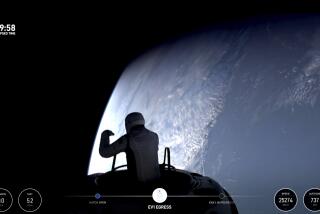Shuttle Crew Takes Spacewalk to Test ‘Floating Eyeball’ Camera
- Share via
KENNEDY SPACE CENTER, Fla. — A spacewalking astronaut tossed out a robotic camera Wednesday and then leaned back and watched with delight as the ball soared 40 feet above space shuttle Columbia on its own.
The white sphere, about the size of a beach ball, flitted above and about Columbia’s open cargo bay for more than an hour in the first test of its kind.
All the while, it beamed down dizzying TV views of the shuttle from nose to tail, upside down and right-side up.
As soon as spacewalker Winston Scott got his gloved hands back on the roaming eye, its remote-control operator announced “a home run.”
“I think we’ve got a real winner here,” pilot Steven Lindsey reported from the cockpit. “It flew even better than I expected. We’re real pleased.”
The debut of NASA’s so-called Aercam Sprint was a warmup for the soon-to-be-built international space station. Engineers say an even smarter and more self-sufficient model could inspect the outer fringes of the station and thereby reduce the number of spacewalks needed.
“Having this kind of floating eyeball in our hip pocket available when we need it for the space station is going to be, I expect, worth its weight in gold over the next few years,” said Gregory Harbaugh, acting manager of NASA’s spacewalks project.
The $3-million camera, padded for protection and equipped with tiny nitrogen thrusters and a floodlight, was supposed to be released during a spacewalk last week. Scott and his Japanese spacewalking partner, Takao Doi, had to skip the experiment, however, to catch a runaway science satellite. They also didn’t have enough time to thoroughly test a station-building crane.
Late Monday, Mission Control added a second spacewalk so everything could be accomplished.
The five-hour outing was NASA’s last until construction begins next summer on the international space station.
More to Read
Sign up for Essential California
The most important California stories and recommendations in your inbox every morning.
You may occasionally receive promotional content from the Los Angeles Times.








